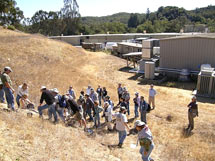
Handy Links
SLAC News Center
SLAC Today
- Subscribe
- Archives: Feb 2006-May 20, 2011
- Archives: May 23, 2011 and later
- Submit Feedback or Story Ideas
- About SLAC Today
SLAC News
Lab News
- Interactions
- Lightsources.org
- ILC NewsLine
- Int'l Science Grid This Week
- Fermilab Today
- Berkeley Lab News
- @brookhaven TODAY
- DOE Pulse
- CERN Courier
- DESY inForm
- US / LHC
SLAC Links
- Emergency
- Safety
- Policy Repository
- Site Entry Form

- Site Maps
- M & O Review
- Computing Status & Calendar
- SLAC Colloquium
- SLACspeak
- SLACspace
- SLAC Logo
- Café Menu
- Flea Market
- Web E-mail
- Marguerite Shuttle
- Discount Commuter Passes
-
Award Reporting Form
- SPIRES
- SciDoc
- Activity Groups
- Library
Stanford
Around the Bay
The Ground Beneath Our Feet
 Last Saturday, 40 members of the Society for Sedimentary Geology drove down Loop Road, passed through the Sector 30 gate, and arrived on the north side of the
klystron gallery. Stretching before them, the earthen walls of the accelerator trench cut an enticing swath through the foothills, holding the secrets to a story that began more than 55 million years ago.
Last Saturday, 40 members of the Society for Sedimentary Geology drove down Loop Road, passed through the Sector 30 gate, and arrived on the north side of the
klystron gallery. Stretching before them, the earthen walls of the accelerator trench cut an enticing swath through the foothills, holding the secrets to a story that began more than 55 million years ago.
Led by geologists Susan Witebsky from SLAC's Environmental Protection Department and Ken Ehman of Chevron, the enthusiastic group of students, academic researchers and professional geologists explored SLAC's most exciting geological sites.
"I was so excited when I saw the map with the aerial view of SLAC," said a geology student from California State University, Long Beach. "There's such a deep, clean line of exposed sediment. You can really learn a lot from a site like this."
Geologists have been interested in the area since 1959, when they began investigating the land as a prospective site for the linear accelerator. Searching for potential hazards to the linac's construction and operation, they bored holes 100 feet deep, fortuitously revealing clues to the land's oceanic history.
SLAC's campus rests on a two-mile-thick bed of marine sedimentary rock, a rigid reminder of the waters that covered the land until only recently. Over 50 million years ago, the ground on which SLAC rests was the deep ocean floor. Since then, it has been gradually rising, breaking through the water's surface a mere 1 to 2 million years ago. Each era left its distinctive mark in the earth, depositing minerals and fossilized creatures for today's geologists to piece together.
Last weekend, Witebsky and Ehman guided the enthusiastic geologists through the highlights of SLAC's tectonically turbulent history. Beginning in the Visitor's Center, the group heard the tale of Paleoparadoxia, that curious beast that was discovered, excavated and reconstructed by the diligent and passionate Adele Panofsky. Down at the west end of the accelerator, near Sector 0, they examined a large mass of land which had, some millions of years ago, been inverted through faulting and folding. A few hundred meters to the south, they studied 165-million-year-old rocks encrusted with algae a mere 40 million years in age, indicating a tremendous deformation of the earth’s surface. Remarkably, these rocks were originally 15 kilometers below the ground, but 40 million years ago were thrust upward to the shallow ocean floor.
Certain curiosities, however, remain open questions, such as a glaring 20 million year gap in deposits, and maverick blocks of sandstone in the otherwise uniform mudstone matrix at Sector 11.
Although Witebsky has been at SLAC for over 10 years, the rocks continue to excite and intrigue her. "Our primary job is environmental restoration, and evaluating the ground water quality," she said of the SLAC resident geologists. "But every time there's an excavation, like for the Linac Coherent Light Source, we get to come along and see what's revealed. That's the real treat."
—Elizabeth Buchen, SLAC Today, October 11, 2007
Above image: Last Saturday, 40 geologists explored SLAC's geological history, including the Whiskey Hill Formation near Sector 0, shown here.